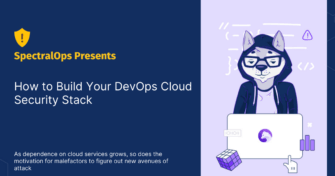5 Bad Coding Habits That Leave Your Source Code Exposed
In 2020 the average cost of a data breach was $3.86 Million. There are many ways that you can be proactive about your security to prevent
The cloud gives you agility, speed, and flexibility – but it also opens new doors for attackers.
For DevOps teams, every line of code, every container, and every deployment pipeline is a potential entry point and missteps are easier than ever.
Misconfigurations alone cause 80% of all security breaches in cloud environments, so the stakes are even higher. This poses a severe security risk with wide-ranging consequences, making it evident that cloud-native environments demand a new security mindset.
It’s all about going beyond traditional checkpoints and weaving security into every part of your workflow. Because the only way to stay ahead from emerging threats is to secure everything in the cloud – from code to container.
Cloud-native security is about protecting applications built to run in the cloud. Unlike traditional apps, these cloud-native ones use microservices, containers, serverless functions, and CI/CD pipelines, making them faster to deploy but also more complex to secure. These architectures require security measures that are:
Unlike traditional approaches focused on securing the network perimeter, cloud-native security takes a full-lifecycle approach, covering everything from code development to deployment and runtime protection.
Cloud-native applications are built for speed and scalability, with frequent updates and new deployments that traditional security simply can’t keep pace with. For example, in a microservices environment, a single service might scale independently or be updated multiple times a day.
When security isn’t built into these cloud-native workflows, it’s easy for issues like misconfigurations, unpatched code, and vulnerable APIs to escalate into breaches, downtime, and costly compliance violations.
Here’s a look at the core security challenges in cloud-native environments – and why dealing with them early makes all the difference in keeping your applications safe:
The key is to recognize that these challenges do not exist in isolation. Misconfigurations, dependency risks, network vulnerabilities, and poor secrets management can compound each other’s impact. A misconfiguration in your network might expose a microservice dependent on an outdated library, or a misplaced secret could grant access to exploit these issues.
In cloud-native environments, secure code practices take on a new level of importance, as each microservice or container functions like an independent unit with its own security needs.
A modular approach secures each component individually – applying secure coding standards, sanitizing inputs, and managing secrets at the service level to limit access and contain threats.
This ties directly into the shift-left strategy, which means embedding security checks early in the development process so vulnerabilities are caught when they’re easiest and cheapest to fix. Instead of waiting for post-deployment audits or runtime monitoring to reveal issues, you catch them as code is written, ensuring fewer surprises later.
Zero-trust is fundamental. This means that every access request needs to be verified and strictly controlled. You can implement this by using role-based access control (RBAC) along with least privilege principles, so permissions stay lean. For high-risk areas, add multi-factor authentication (MFA) and automated credential rotation.
In multi-cloud setups, federated identity management can streamline user access and apply consistent security. For example, if you restrict access to production databases with IAM policies, it significantly reduces the risk of data exposure.
By dividing your network into isolated segments, you can limit potential attack paths. For example, setting up Virtual Private Clouds (VPCs) or custom subnetting allows you to separate sensitive resources from public-facing ones. Network policies or security groups should only allow necessary communication between these segments.
Tools like Amazon CloudWatch or Datadog gather logs from all cloud services, making it easier to spot anything unusual. Set up alerts for patterns that might signal trouble, like a spike in traffic or unexpected login attempts.
For example, if you notice a sudden jump in API calls to a specific service, your monitoring tools can flag it so your team can investigate before it becomes a bigger problem.
Harden your infrastructure by automating updates and patches with Infrastructure as Code (IaC) tools. This helps your infrastructure configurations remain secure and compliant. Use CIS Benchmarks for cloud providers like AWS, Azure, and GCP as a guideline for hardening your environment.
Begin with trusted, vulnerability-scanned images, and monitor containers in real time with tools like Spectral‘s docker image scanning, to catch any strange behavior. Limit resources within Kubernetes to prevent any container from hogging memory or CPU, and use namespaces to keep sensitive containers separated. An example here is setting limits on container resources to avoid denial-of-service risks, especially within a Kubernetes cluster.
Drive secure coding practices by integrating specific security checks at every stage of development. Start by embedding SAST tools directly into your IDEs and pipeline, so vulnerabilities are flagged as code is written and pushed. Configure these tools to look for issues like hardcoded secrets, SQL injection risks, and weak cryptographic functions, providing instant feedback to developers.
In CI/CD pipelines, incorporate DAST tools to simulate real-world attacks on staging environments, uncovering runtime vulnerabilities that static analysis may miss.
The speed of DevSecOps makes it perfectly suited to cloud-native environments, where rapid development and frequent releases are the norm. In a DevSecOps approach, the pipeline becomes a powerful checkpoint, where automated scans, policy checks, and compliance validations can run directly alongside code changes. Development teams can catch and resolve vulnerabilities immediately – without interrupting their workflows.
The goal of cloud-native security is to always be one step ahead. Instead of waiting until the end to secure things, you’re building security into every tier of your application – from the code your team writes to the containers they deploy. With the speed of today’s development cycles, security can’t just sit on the sidelines.
For more comprehensive protection, consider leveraging Spectral’s platform to embed security directly into your CI/CD workflows, offering automated, early identification of vulnerabilities before they become threats. From scanning code to monitoring configurations, or uncovering hidden risks, Spectral provides fast, zero-config solutions that keep up with the pace of your cloud-native environment.
With seamless integration into GitHub, GitLab, Jenkins, and more, you can shift-left with Spectral’s pre-commit hooks, advanced AI-driven detection, and support for real-time scanning. Spectral is purpose-built to identify and mitigate risks across every asset, from secrets to sensitive log data.
Ready to secure every line of code and every deployment? Start implementing cloud-native security with Spectral today!

In 2020 the average cost of a data breach was $3.86 Million. There are many ways that you can be proactive about your security to prevent

For a long time, the best approach to network and data security was network segregation. If you protect your intranet from the Internet, there are significantly

Did you know that Kubernetes is one of the leading open-source projects globally, boasting contributors from Google, Microsoft, and many other tech giants? Kubernetes enjoys the